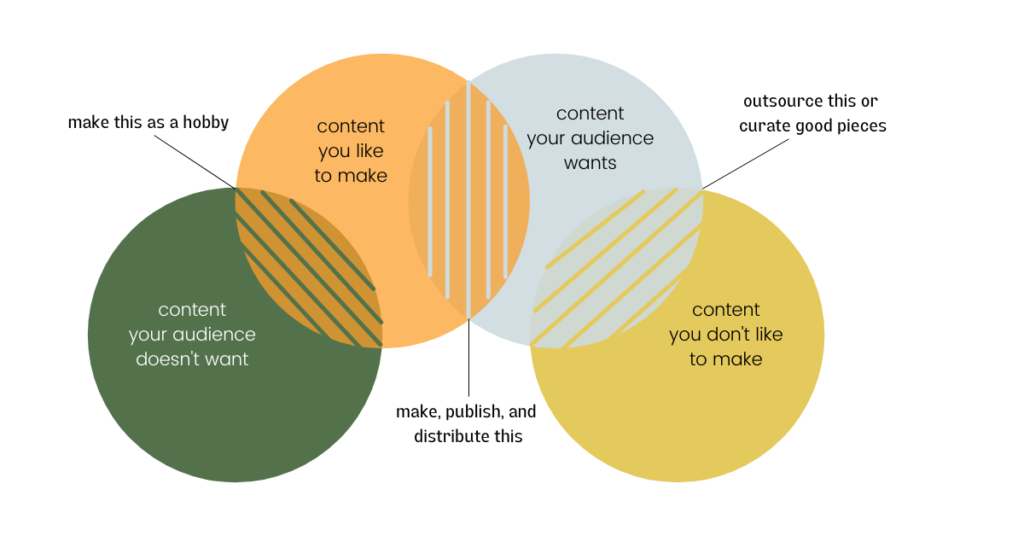TL;DR? Skip to the end for a video wrapup.
Marketing is hard when you hate making content. Surprisingly, it can also be hard when you love making content.
Whether making it is a joy or a chore, if your content isn’t attracting the right attention, it’s not doing its job. There’s a formula for figuring out if a specific piece is going to be worth the effort.
This formula divides all content into four overlapping segments.
- First, you have content you like to make. Maybe you love writing blog posts. Perhaps video is your jam. Or maybe you’re a visual type who likes to put ideas into graphic form. There are plenty of other options too. The point is, this is stuff that’s fun to make.
- Second, you have content you hate to make. Maybe you don’t mind being on camera but you’d rather go to the dentist than write a blog. Chances are there’s at least one medium that fills you with anxiety, dread, or some other icky, nasty emotion.
- Third, you have content your audience wants. It’s what they enjoy consuming. When they have a decision to make, this is the thing they look for.
- Finally, you have content your audience doesn’t want. It’s the platforms they’re not on, the media they don’t consume, and the formats they don’t trust for reliable information.
This is why content marketing is as hard for the people who love creating as it is for the people who hate it. If the content you love to make is not what your audience wants, it won’t do its job no matter how much you crank out.
Target content in the in-between spaces
Most people are focused on the buckets: either on making what they want or on making what their audience wants. Where you want to focus is in the spaces between.

1. You Like to Make It But Your Audience Doesn’t Want It
Let’s say Rose loves writing long, informative blog posts. She’s committed to it: she publishes at least one new post a week, sometimes more. Her SEO is picking up and she’s getting some decent engagement, but it’s not translating into sales for her beauty brand.
The thing is, when Rose’s audience is looking for new beauty products, they’re not real excited about long blog posts. What they want to see are the products in action. Beauty is a visual concept and Rose’s content is giving them nothing but words.
So, should Rose give up writing? Of course not! She likes it. It brings her joy. But she should refocus her content strategy. Her blog is a supporting player, not the star of the show.
2. Your Audience Wants It But You Don’t Want to Make It
Now Rose has a new problem. She hates photography. There’s all the prep beforehand – setting up the lights, the backdrop, all her supplies – and the cleanup after. And then there’s the editing, which she’s not very good at.
Rose has a few options to bring visual media into her content plan. First, she could choose to not give her audience what they want. Bold move and pretty risky.
Second, she could grit her teeth and make the content. She’ll dread creation days, which makes it hard to create consistently. She may take shortcuts, and her lack of enthusiasm will show. In short, she’ll make herself miserable for inconsistent, mediocre results.
Third, she could curate visual content. This could work very well for a beauty brand. Rose could ask customers for photos and videos of them using her products. There will still be some work to get, sort, and format the content, but at least Rose doesn’t have to use a camera.
Finally, she could outsource it. She could hire influencers to create and post visual content she can share. She could hire a photography or video company to create the content for her – branded to her company and made exact to her specifications.
This option costs money upfront, but yields positive ROI in the long term. Just as important, it saves time, energy, and misery.
And finally, the holy grail.

3. Your Audience Wants It And You Like to Make It
In the course of her experiments, let’s say Rose hit upon something she didn’t know about herself. While she’d rather stub her toe than shoot a tutorial, creating graphics that highlight the benefits of her products is pretty fun, and gives her a chance to direct viewers to the blog for more information.
What’s more, her audience responds. The eye-catching graphics stop their scrolling and inspire them to learn more. Traffic and conversions slowly but surely start to rise.
This is the intersection where Rose should spend her energy – on content both the creator and the audience enjoy.
Here’s the TL;DR: If you love making content but you’re not seeing any payoff from your efforts, stop and ask if what you’re making is what your audience is looking for. If not, either shift gears or outsource the content they’re demanding to a professional who likes to make it.
(If the content you need is written, I know someone. She’s pretty great.) 😉
Life’s short. Be happy.

“A motivating discussion is worth comment. There’s no doubt that that you ought to publish more about this topic, it might not be a taboo matter but usually people don’t discuss such topics. To the next! All the best!!”
https://tincneatin.ucoz.ru/news/mcvins_naarvt_livvi_lbitks/2022-01-20-76
Glad it resonated with you! I don’t think it’s taboo; I think people just think about it in a more complicated manner. Thanks for chiming in!
How is the COVID situation over there?